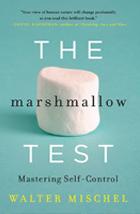A Review of "The Marshmallow Test: Mastering Self Control" by Walter Mischel
Reviewed by Ronnie Dietrich, Senior Fellow, The Wing Institute, Oakland, California
Very few psychological experiments become well known within the discipline. Even fewer become well known in the larger culture. The Marshmallow Test by Walter Mischel and colleagues is the exception. Since the original study was published in 1970 it has been replicated and extended many times. Not only is it well known in the larger culture but it is one of the foundational experiments in the related sub-disciplines of delay discounting and behavioral economics. In the book, The Marshmallow Test: Mastering Self Control (2014), Walter Mischel summarizes all that has been learned in the 40+ years of research on self-control using the marshmallow test as the experimental arrangement. The experiment is elegant in its simplicity. The basic arrangement was that the children were told that they could have one marshmallow now or two if they waited until the experimenter returned. The child was then left in the room with the one marshmallow sitting in front of them.
 The book is divided into three sections. The first reviews the results from the early experiments, proposes mechanisms for how children who waited did so, and explores the possibility that the ability to tolerate delay is genetically determined. In proposing the mechanisms to account for the ability to tolerate delay, Mischel using the metaphor of hot systems (impulsive) and cool systems (self-control) and links these systems to neural structures. The proposed hot/cool systems are very similar to those proposed by the behavioral economist, Daniel Kahneman, in his recent book, Thinking Fast and Slow. In Mischel’s formulation the hot system had important functions for survival in humans' early evolutionary history but as environmental threats to survival have been eliminated the hot system leads to impulsive choices that ultimately are harmful to the individual. He links the influence of the hot system to such issues as over-eating, drug and alcohol addictions, and anger control problems. The cool system developed much later in human evolutionary history and is responsible for making self-control choices result in reinforcement later rather than immediately which results in healthier lifestyle and greater financial and professional success. Whether the hot/cool systems are metaphorical or, in fact, real is largely irrelevant to the larger point-some individuals show greater tolerance for delay of reinforcement and those individuals are more likely experience a wide range of positive outcomes than those who seem to more influenced by the hot system. More importantly, the two systems approach has lead researchers to develop important intervention strategies for teaching individuals to tolerate delay, which is the focus of the third section of the book.
The book is divided into three sections. The first reviews the results from the early experiments, proposes mechanisms for how children who waited did so, and explores the possibility that the ability to tolerate delay is genetically determined. In proposing the mechanisms to account for the ability to tolerate delay, Mischel using the metaphor of hot systems (impulsive) and cool systems (self-control) and links these systems to neural structures. The proposed hot/cool systems are very similar to those proposed by the behavioral economist, Daniel Kahneman, in his recent book, Thinking Fast and Slow. In Mischel’s formulation the hot system had important functions for survival in humans' early evolutionary history but as environmental threats to survival have been eliminated the hot system leads to impulsive choices that ultimately are harmful to the individual. He links the influence of the hot system to such issues as over-eating, drug and alcohol addictions, and anger control problems. The cool system developed much later in human evolutionary history and is responsible for making self-control choices result in reinforcement later rather than immediately which results in healthier lifestyle and greater financial and professional success. Whether the hot/cool systems are metaphorical or, in fact, real is largely irrelevant to the larger point-some individuals show greater tolerance for delay of reinforcement and those individuals are more likely experience a wide range of positive outcomes than those who seem to more influenced by the hot system. More importantly, the two systems approach has lead researchers to develop important intervention strategies for teaching individuals to tolerate delay, which is the focus of the third section of the book.
Given the pervasive negative effects of acting impulsively, the strategies for teaching self-control will be of interest to behavioral practitioners regardless of the population they work with. Most of the strategies are based on cognitive-behavioral procedures and involve rehearsal, visualizing, and re-framing stimuli so that the power of the immediate choice is reduced. Mischel gives considerable attention to the efforts of the Knowledge is Power Program (KIPP) charter schools and their efforts to directly teach tolerance for delay. Many of the students enrolled in program have histories of academic failure and poor social-emotional control. Through KIPP’s specific emphasis on developing self-control many of the students have been able to successfully graduate from high school and attend universities. Much of the emphasis is on decision making and encouraging the students to identify the long-term benefits of the self-control option and how making a self-control choice now helps them achieve their long term goals.
The third section of the book focuses on the public policy implications of what has been learned from the Marshmallow test and how explicitly teaching self-control in public schools may impact the toxic effects of living in high stress situations like poverty, abusive families, and high crime neighborhoods. Mischel powerfully argues that the costs to individuals and society are very high if we fail to address the problems of impulsivity. The interventions used in public schools are relatively low cost and easy to implement. The benefits to educators are relatively immediate-improved academic performance and better social behavior. The benefits to the larger society are enormous in terms of lower crime rates, reduced drug and alcohol addiction, and a more educated citizenry. Mischel makes the case that we cannot afford to ignore what we know about improving self-control.
This book is recommended to anyone who is interested in child development and addressing the larger problems that we face as a society. The story is told in an engaging, informal voice. It is well-written and easily accessible for the larger public with minimal reliance on technical language.



